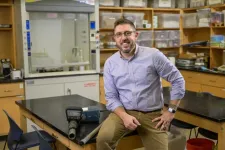(Press-News.org) Let’s say you typically eat eggs for breakfast but were running late and ate cereal. As you crunched on a spoonful of Raisin Bran, other contextual similarities remained: You ate at the same table, at the same time, preparing to go to the same job. When someone asks later what you had for breakfast, you incorrectly remember eating eggs.
This would be a real-world example of a false memory. But what happens in your brain before recalling eggs, compared to what would happen if you correctly recalled cereal?
In a paper published in Proceedings of the National Academy of Sciences, University of Pennsylvania neuroscientists show for the first time that electrical signals in the human hippocampus differ immediately before recollection of true and false memories. They also found that low-frequency activity in the hippocampus decreases as a function of contextual similarity between a falsely recalled word and the target word.
“Whereas prior studies established the role of the hippocampus in event memory, we did not know that electrical signals generated in this region would distinguish the imminent recall of true from false memories,” says psychology professor Michael Jacob Kahana, director of the Computational Memory Lab and the study’s senior author. He says this shows that the hippocampus stores information about an item with the context in which it was presented.
Researchers also found that, relative to correct recalls, the brain exhibited lower theta and high-frequency oscillations and higher alpha/beta oscillations ahead of false memories. The findings came from recording neural activity in epilepsy patients who were already undergoing invasive monitoring to pinpoint the source of their seizures.
Noa Herz, lead author and a postdoctoral fellow in Kahana’s lab at the time of the research, explains that the monitoring was done through intracranial electrodes, the methodology researchers wanted to use for this study. She says that, compared to scalp electrodes, this method “allowed us to more precisely, and directly, measure the neural signals that were generated in deep brain structures, so the activity we are getting is much more localized.”
Subjects studied a list of unrelated words and were distracted before being asked to remember words, says Herz, now an assistant professor of neurology at Thomas Jefferson University, in Philadelphia. Researchers analyzed patterns of electricity generated in the hippocampus, capturing brain activity leading up to correct or false recall.
Beyond the distinction between true and false memories, researchers predicted that activity in the hippocampus would reflect the degree of similarity between the correct and false memory. They indeed found that a notable reduction in low-frequency activity was associated with greater similarity between the contexts in which false and correct items were learned.
A similar context in this study meant a patient recalling a word from a prior list in the experiment instead of the target list, whereas a different context is recalling a word that was never part of the experiment.
“The words were presented when the patient was sitting in the same room, looking at the same computer, having the same experimenter next to him,” Herz says, “and these words were also presented more recently in time, so all of these different factors mean that prior list intrusions should be more similar, in terms of the context in which they were presented, to the correct target list.”
This was a way of testing hippocampal response to different words presented from similar source contexts, but what happens in the brain when someone recalls a word that is incorrect but semantically similar to the right word? Researchers tested this, too.
They showed patients words in three categories, such as flowers, fruits, and insects. As an example, Herz says if the list includes “rose” and “lily” but a person recalls “sunflower,” that is semantically similar whereas saying “clock” is not. But perhaps “clock” was on a prior word list in the study; the paper notes a recalled word tends to be similar in at least one context, either source or semantic.
As hypothesized, researchers found the same brain pattern with semantic similarity as they did with source similarity: a reduction in hippocampal low-frequency activity.
Herz says the overall findings deepen the understanding of how the brain enables memory retrieval, and the authors note that predicting false memories at a single-subject level is particularly important when false recalls cause distress.
“Individuals suffering from stress-related psychopathology, such as post-traumatic stress disorder, often experience memory intrusions of their traumatic experiences under contexts that are safe and dissimilar to the traumatic incident. Targeted interventions that disrupt retrieval of intrusive memories could spawn novel therapies for such clinical conditions,” the researchers write.
Michael Kahana is the Edmund J. and Louise W. Kahn Term Professor of Psychology in the School of Arts & Sciences and director of the Computational Memory Lab at the University of Pennsylvania.
Noa Herz is an assistant professor of neurology at Thomas Jefferson University and a former postdoctoral fellow in the Kahana’s lab at the University of Pennsylvania.
Other co-authors are Penn’s Bernard Bukala, a former research intern in the Computational Memory Lab, and James Kragel of the University of Chicago.
END
How the hippocampus distinguishes true and false memories
2023-10-02
ELSE PRESS RELEASES FROM THIS DATE:
Drier savannas, grasslands store more climate-buffering carbon than previously believed
2023-10-02
Photos
Savannas and grasslands in drier climates around the world store more heat-trapping carbon than scientists thought they did and are helping to slow the rate of climate warming, according to a new study.
The study, published online Oct. 2 in Nature Climate Change, is based on a reanalysis of datasets from 53 long-term fire-manipulation experiments worldwide, as well as a field-sampling campaign at six of those sites.
Twenty researchers from institutions around the globe, including two at the University of Michigan, looked at where and why fire has changed the amount of carbon stored in topsoil. They found that within savanna-grassland regions, ...
Ancient architecture inspires a window to the future
2023-10-02
A centuries-old technique for constructing arched stone windows has inspired a new way to form tailored nanoscale windows in porous functional materials called metal-organic frameworks (MOFs).
The method uses a molecular version of an architectural arch-forming “centring formwork“ template to direct the formation of MOFs with pore windows of predetermined shape and size.[1]. New MOFs designed and made in this way range from narrow-windowed materials with gas separation potential to larger-windowed structures with potential medical applications due to their excellent oxygen-adsorption capacity.
“One of the most challenging ...
Climate and human land use both play roles in Pacific island wildfires past and present
2023-10-02
DALLAS (SMU) – It’s long been understood that human settlement contributes to conditions that make Pacific Islands more susceptible to wildfires, such as the devastating Aug. 8 event that destroyed the Maui community of Lahaina. But a new study from SMU fire scientist Christopher Roos published in the journal Nature Ecology and Evolution shows that climate is an undervalued part of the equation.
Roos, SMU environmental archaeologist and professor of anthropology, traveled with his team to the Sigatoka ...
DeepMB: a deep learning framework for high-quality optoacoustic imaging in real-time
2023-10-02
Researchers at Helmholtz Munich and the Technical University of Munich have made significant progress in advancing high-resolution optoacoustic imaging for clinical use. Their innovative deep-learning framework, known as DeepMB, holds great promise for patients dealing with a range of illnesses, including breast cancer, Duchenne muscular dystrophy, and inflammatory bowel disease. Their findings have been now published in Nature Machine Intelligence.
In order to understand and detect diseases scientists and medical staff often rely on imaging methods such as ultrasound or X-ray. However, ...
Overlooked parts of proteins revealed as critical to fundamental functions of life
2023-10-02
According to textbooks, proteins work by folding into stable 3D shapes that, like Lego blocks, precisely fit with other biomolecules.
Yet this picture of proteins, the "workhorses of biology," is incomplete. Around half of all proteins have stringy, unstructured bits hanging off them, dubbed intrinsically disordered regions, or IDRs. Because IDRs have more dynamic, “shape-shifting” geometries, biologists have generally thought that they cannot have as precise of a fit with other biomolecules as their folded ...
Not the usual suspects: New interactive lineup boosts eyewitness accuracy
2023-10-02
Allowing eyewitnesses to dynamically explore digital faces using a new interactive procedure can significantly improve identification accuracy compared to the video lineup and photo array procedures used by police worldwide, a new study reveals.
Interactive lineups present digital 3D faces that witnesses can rotate and view from different angles using a computer mouse - enabling witnesses to actively explore and match faces to their recollection.
Publishing their findings today (2 Oct) in Proceedings of the National Academy of Sciences, psychologists found that the interactive procedure enhanced people’s ability to correctly identify perpetrators and avoid misidentifications.
Lead ...
Yang developing training dataset labeling tool
2023-10-02
Chaowei Yang, Professor, Director, NSF Spatiotemporal Innovation Center, Geography and Geoinformation Science, received funding from the National Science Foundation for the project: "I-Corps: An automatic training dataset labeling tool for producing large amount of quality training datasets."
He and his collaborators are interviewing more than 100 potential customers to: a) identify a customer sector that has the potential to show early success, b) define from a customer perspective a Minimum Viable Product (MVP), c) explore the potential and plan to create a startup by a team composed of ...
Loneliness and risk of Parkinson disease
2023-10-02
About The Study: This study of 491,000 participants followed up for up to 15 years found that loneliness was associated with risk of incident Parkinson disease across demographic groups and independent of depression and other prominent risk factors and genetic risk. The findings add to the evidence that loneliness is a substantial psychosocial determinant of health.
Authors: Antonio Terracciano, Ph.D., of the Florida State University College of Medicine in Tallahassee, is the corresponding author.
To access the embargoed study: Visit our For The Media website at this link https://media.jamanetwork.com/
(doi:10.1001/jamaneurol.2023.3382)
Editor’s ...
Paxlovid and COVID-19 mortality and hospitalization among patients with vulnerability to COVID-19 complications
2023-10-02
About The Study: In this study of 6,866 individuals with COVID-19, nirmatrelvir and ritonavir (Paxlovid [Pfizer]) treatment was associated with reduced risk of COVID-19 hospitalization or death in clinically extremely vulnerable individuals, with the greatest benefit observed in severely immunocompromised individuals. No reduction in the primary outcome (death from any cause or emergency hospitalization with COVID-19 within 28 days) was observed in lower-risk individuals, including those age 70 or older without serious comorbidities.
Authors: Colin R. Dormuth, Sc.D., ...
Discrimination alters brain-gut ‘crosstalk,’ prompting poor food choices and increased health risks
2023-10-02
People frequently exposed to racial or ethnic discrimination may be more susceptible to obesity and related health risks in part because of a stress response that changes biological processes and how we process food cues. These are findings from UCLA researchers conducting what is believed to be the first study directly examining effects of discrimination on responses to different types of food as influenced by the brain-gut-microbiome (BGM) system.
The changes appear to increase activation in regions of the brain associated with reward and self-indulgence – like seeking “feel-good” ...


